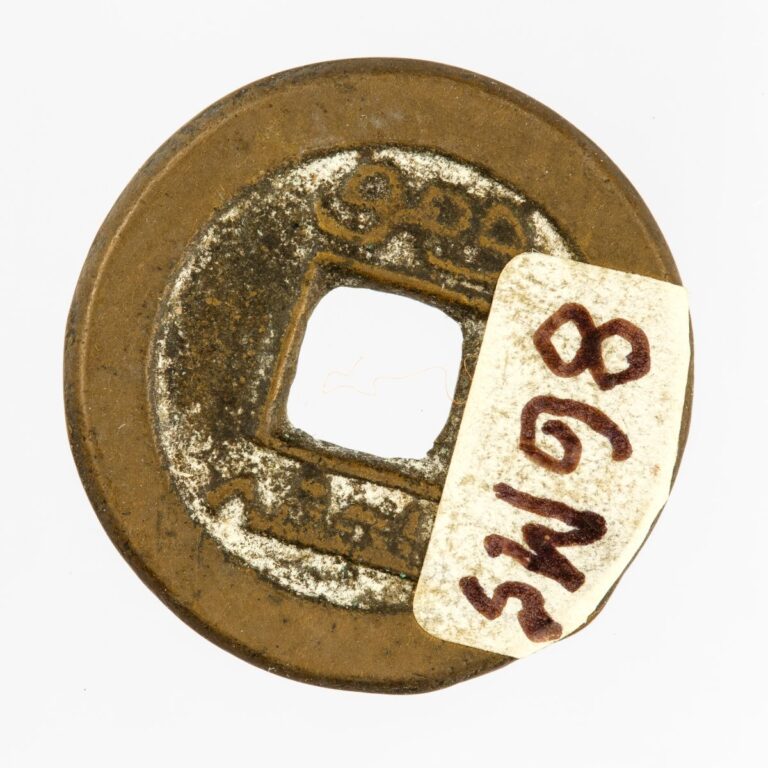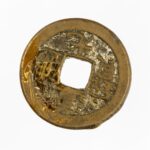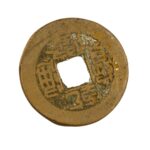Coin Daoguang tongbao
A round copper alloy coin with a square hole in the centre, called fangkong qian 方孔錢. These appeared in various denominations, mostly as tongbao 通寶 (“ordinary currency”) coins, which were worth one monetary unit, and yuanbao 元寶 (“original currency”) and zhongbao 重寶 (“heavy currency”), which had a higher face value. Such coins were in circulation as standard money, in many varieties and denominations, from the time of Emperor Gaozu 高祖 (reigned 618–626), first emperor of the Tang Dynasty (618–907), until the end of the Qing Dynasty (1644–1912). The inscription on the coin usually consists of two characters, reading from top to bottom, indicating the name of the imperial reign or the single reign period (nianhao 年號) in which the coin was minted. The other two characters are read from right to left. On the left-hand side of the coin, we always find the character bao 寶 ... more
A round copper alloy coin with a square hole in the centre, called fangkong qian 方孔錢. These appeared in various denominations, mostly as tongbao 通寶 (“ordinary currency”) coins, which were worth one monetary unit, and yuanbao 元寶 (“original currency”) and zhongbao 重寶 (“heavy currency”), which had a higher face value. Such coins were in circulation as standard money, in many varieties and denominations, from the time of Emperor Gaozu 高祖 (reigned 618–626), first emperor of the Tang Dynasty (618–907), until the end of the Qing Dynasty (1644–1912). The inscription on the coin usually consists of two characters, reading from top to bottom, indicating the name of the imperial reign or the single reign period (nianhao 年號) in which the coin was minted. The other two characters are read from right to left. On the left-hand side of the coin, we always find the character bao 寶 (wealth, preciousness), which in combination with the character on the right means “currency” or “money in circulation”. This is most often the character tong 通 (circulate, be uniform, general, or universal), but often it is also yuan 元 (original) or zhong 重 (weight), which usually denote coins with a larger face value. Thus, the entire inscription literally means “money in circulation during the time of this or that emperor” or “during this or that period of the reign of a single emperor”. Coins from the time of the last, Manchu Qing dynasty have, in addition to the inscription in four Chinese characters on the obverse, an inscription on the reverse, usually indicating the location of the mint. It was originally written in Chinese, then in Chinese and Manchu, and finally only in Manchu.
The coin shown is well preserved, so the Chinese characters Daoguang tongbao 道光通寶 can be easily read on the obverse, which means that it was minted during the reign of Emperor Daoguang 道光 (reigned 1820–1850).
By his time, the Qing Dynasty was already facing many challenges, most notably related to the First Opium War (1839–1842) and the beginning of the Taiping Rebellion (1850-–1864). The dispute regarding the opium trade and the subsequent military intervention were very costly, resulting in a shortage of money supply. The quality of the coins was already deteriorating, and they were becoming more expensive to produce relative to their actual value. Nevertheless, the coin is of relatively good quality. The inscription on the reverse is written entirely in Manchu script. On the left is written from top to bottom boo ᠪᠣᠣ, which is a phonetic transcription of the Chinese bao meaning “money”, “treasure”, or “currency”, while on the right is the Manchu inscription ciowan ᠴᡳᠣᠸᠠᠨ, a phonetic transcription of the Chinese term quan 泉 meaning “source”. The full spelling, boo ciowan ᠪᠣᠣ ᠴᡳᠣᠸᠠᠨ, is a Manchu phonetic approximation of the Chinese term baoquan 寶泉, meaning “source of wealth”, and indicates that the coin was minted at a mint under the administration and supervision of the Bureau of Revenue (Hubu 戶部) in Beijing. (MG)







































Do you have a comment or additional information about the subject?